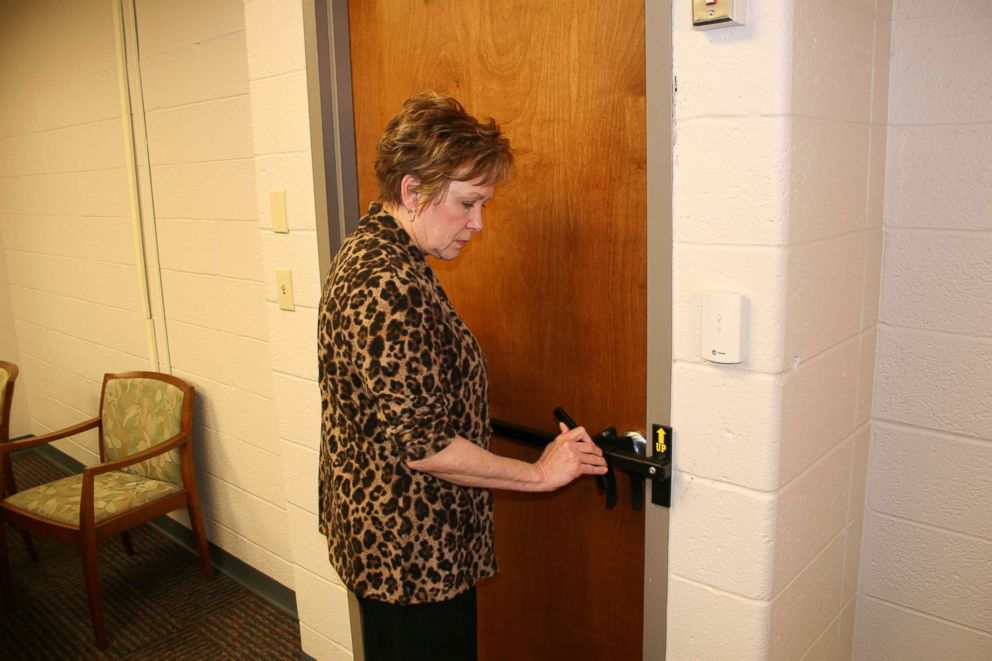Schools preparing for active shooters the wrong way, experts say
— -- “Run, hide, fight” has been the Department of Homeland Security’s best advice to people who find themselves in mass shooting situations since the aftermath of the Sandy Hook Elementary School shooting, but some experts say hiding is the worst thing victims can do when bullets start flying and recommend DHS drop that advice altogether in favor of just "Run, fight."
Active shooter prevention expert Chris Grollnek estimates that more than 90 percent of fatalities in at least 13 active shootings he has studied were because the victims were trying to hide.
The average distance victims in mass shootings are shot from is just 18 inches, according to Greg Shaffer, a former FBI special agent and member of the bureau’s elite Hostage Rescue Team and founder of Shaffer Security Group, which specializes in active shooter response.
“Those hiding under desks are just making themselves easy targets,” Shaffer told ABC News.
DHS recommends people find an "accessible escape path" and run to evacuate the premises in the event of an active shooter. But if an evacuation isn't possible, they advise finding a place to hide "where the active shooter is less likely to find you."
But hiding should be an absolute last resort, Shaffer said.
“Hiding under your desk is hands-down the wrong thing to do,” Shaffer said. “There needs to be a new shift to stress the importance of getting out of the school building.”
In the 19 years since 12 students and a teacher lost their lives in the Columbine shooting, schools around the country drill for active shooters as they do for fires or bomb threats, but the central tenet of the drills differs.
In fire drills or bomb threats, students practice moving away from the danger by evacuating the building, but in lockdown drills for active shooters, teachers and students are taught to shelter in place in the same building with the gunman, often without proper doors and locks to barricade themselves, or weapons to defend themselves, experts said.
“If someone told you there was a bomb in your building, would you get under your desk or would you leave the building?” Grollnek asked. “You would get out. An active shooter is the same thing as a ticking bomb in your building.”
Both Grollnek and Shaffer agree that unless teachers and students know the gunman is right outside their classroom door, they should make every effort to evacuate the building and move away from the gunman, rather than hide, potentially making themselves easy targets.
“You don’t want to stay there and be hunted by a sociopath,” Shaffer said. “The only exception is if he is right outside your door.”
Shaffer advises the best way to evacuate a classroom during a shooting is out the window, rather than moving the children through hallways that the shooter might be firing down. His own daughter is a special education teacher in Virginia and he advises her to keep heavy cans of soup and a pillowcase in her classroom. In the event of a shooting, she can put the soup cans into the pillowcase and use those everyday items as a bludgeon to break the window and move her students to safety, he said.
If a classroom is not on the ground floor, it becomes more difficult to evacuate children out the window, which is why Shaffer recommends that classrooms are outfitted with emergency ladders, which retail for as little as $35, to move students safely to the ground.
Before teachers can initiate an evacuation of their classroom, Shaffer said they need to be sure the gunman will not be able to enter their room as they’re moving children out the window. He advises schools outfit their classroom doors with hydraulic locks that have a sleeve that teachers can slide over the hinges to prevent the door from being opened.

“In a high-stress situation, you can’t have a door that has to be locked with a key. Your motor skills go out the window under that kind of stress, so doors have to be easily locked,” Shaffer said.
Once the door is locked, teachers need to work with their students to barricade the door with as many heavy pieces of furniture as possible and look for improvised weapons they can use against the shooter in the event he is able to enter the classroom while they are evacuating out the window.
Shaffer also tells his daughter, the special education teacher, to keep a hammer, a box cutter, a screwdriver, wasp spray and a fire extinguisher in her desk. The hammer, box cutter and screwdriver can be used to wound the gunman at close range, while the wasp spray and fire extinguisher can be sprayed at the shooter from a distance. The wasp spray functions much like pepper spray does, while a shot from the fire extinguisher in the eyes will temporarily blind the gunman, Shaffer said.
Mac Hardy, former teacher, police officer and school resource officer and current director of operations for the National Association of School Resource Officers, agrees that in certain circumstances evacuating students may be the best policy, but argues that in other situations, it may not be possible to get students out of the building, and in that case, teachers need to know how to shelter in place effectively.

“Sheltering in place is still a viable option. Evacuating is also an option, but we have to teach teachers where is a safe place to take students so they are behind cover and concealed,” Hardy said.
“It’s not as easy as saying everyone should flee. If I have a class of 20 7-year-olds with me, we aren’t going to move anywhere fast and some of these kids may not be able to move at all because of fear,” he added.
“What you don’t want to do is evacuate into the shooter’s arm,” Randi Weingarten, president of the American Federation of Teachers, said. “That’s part of the reason people said to shelter in place.”
But Weingarten said the idea of evacuation should be considered, especially if it takes the idea of arming teachers off the table.
“Arming teachers would cross a red line of schools becoming armed fortresses instead of sanctuaries of safety and learning,” she said.
Even if teachers have no other choice than to move students through a hallway where a gunman might be shooting, experts say that is still a better option than hiding.
“The hit rate on a moving target is less than 4 percent so by running, you have a 96 percent chance of getting away and even if you are hit, the fatality rate is less than 0.1 percent," Shaffer said.
“Running is always your best option,” Shaffer added.
When asked for comment, DHS referred ABC News to its policy.





